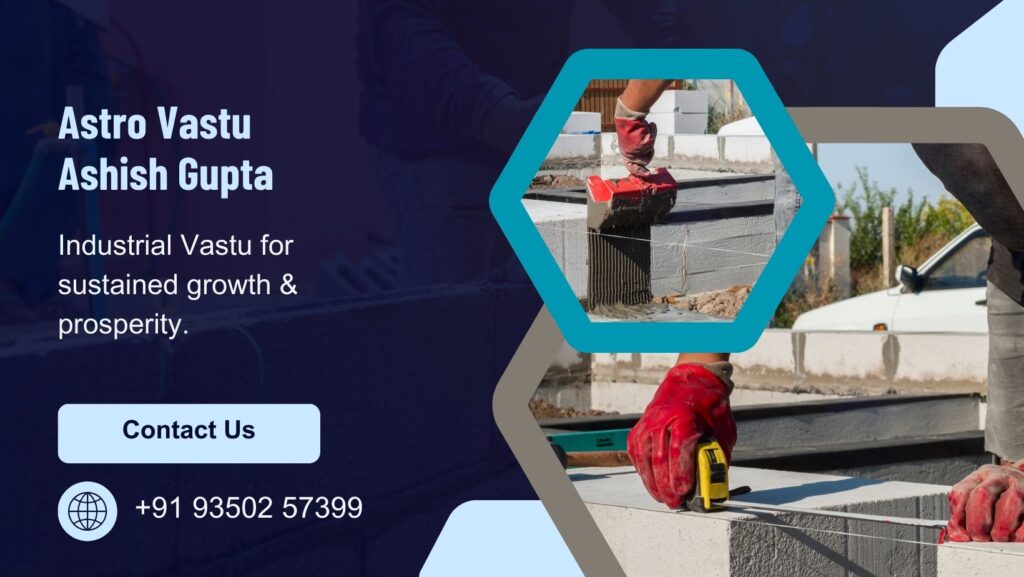Industrial Vastu Principles, Application & Remedies
Vastu Shastra, the ancient India architectural science, emphasis the harmony between nature and the structure. It believes that the proper alignment and orientation of a building can usher in positivity and prosperity. While Vastu is widely applied in residential architecture, its principles are equally essential for industrial establishments. Let’s delve deeper into the principles, application and remedies of Industrial Vastu.
1. Principles of Industrial Vastu
- Directional Importance – Just as in residential Vastu, directions play a pivotal role in industrial vastu too. North, which is associated with wealth, should be kep clear of obstructions. The northeast, symbolizing positive energy, should be free from any heavy machinery or clutter.
- Entrance & Exits – The main entrance should preferably face the East or North direction, ensuring that the primary flow of energy is unhindered. Exits, too, should be appropriately placed to prevent energy leakage.
- Internal Layout – The placement of machinery, storage & workspace is crucial. heavy machinery should ideally be placed in the southern or western zones, ensuring the northern and eastern zones remain open and light.
2. Application of Industrial Vastu
- Site Selection – Before establishing an industrial unit, the site’s selection is paramount. It’s advisable to opt for a plot that’s square or rectangular. Avoid irregular shaped plots. For an irregular shaped plots it is necessary to go for Vastu treatment first in order to balance the energies of earth.
- Building Shape and Design – The shape of the industrial building should be regular without any cuts or extensions. A triangular or L-shaped building can lead to financial losses and operational challenges.
- Flooring and Interiors – The flooring should be uniform and clean. use of colours should be done judiciously with lighter shades being preferred. It is advisable to use zonal element friendly colours. A clutter-free, well-organised workspace ensures smooth operations and increased productivity.
- Ventilation and Lighting – Proper ventilation is essential for any industrial unit. Natural light should be maximised, especially in administrative areas. Good ventilation ensures the free flow of positive energy and a healthy working environment.
3. Remedies in Industrial Vastu
- Mirrors – Mirrors can be strategically placed to correct Vastu doshas. They can deflect negative energies and enhance positivity. However, ensure they aren’t placed facing main entrances or are cracked/damaged.
- Plants – Plants, especially those with broad leaves like money plants, can be placed in the northeast corner of the industrial unit. They help in purifying the air and bringing in positive energy.
- Crystals and Pyramids – Certain crystals and pyramids, when placed in specific zones, can rectify Vastu defects. For instance, a crystal pyramid in the south-western zone can harmonise energies and promote prosperity.
- Water Features – A water fountain or pond in the north east corner can be beneficial. It attracts positive energy and aids in maintaining a balance.
- Regular Cleansing – Regular cleansing and purification rituals, like Vastu poojas, can help in maintaining the sanctity and positivity of the industrial space. Performing regular Yagna is the best activity to maintain the flow of positive energy in the entire industry. this has powers to convert the challenges into blessings.
4. Challenges and Modern Solutions
While traditional Vastu principles have been followed for centuries, modern industrial setups, with their complex machinery and structures, sometimes pose challenges in adhering strictly to Vastu guidelines. However, with some modifications and the right remedies, these challenges can be addressed.
- Vertical Growth – In urban settings where horizontal expansion is limited, industries are opting for vertical growth. Ensuring proper alignment and balance becomes crucial in such scenarios.
- Open Floors Plans – Modern industrial designs ofter incorporate open floor plans for better collaboration and flexibility. While this promotes teamwork, it’s essential to ensure that the fundamental Vastu principles aren’t compromised.
- Integration of Technology – With the rise of industry, the integration of advanced technologies is inevitable. Ensuring that these technological integrations align with Vastu principles requires a blend of traditional knowledge and modern expertise.
Conclusion
Industrial Vastu, while rooted in ancient wisdom, holds relevance even in today’s modern industrial landscape. By understanding and applying the principles of Industrial Vastu, businesses can ensure not just operational efficiency but also sustained growth & prosperity. While challenges may arise due to evolving industrial practises, the essence of Vastu Shastra lies in maintaining harmony between nature, structure, and the energies they encompass. As industries continue to evolve, a harmonious blend of tradition and innovation will pave the way for a prosperous future.







